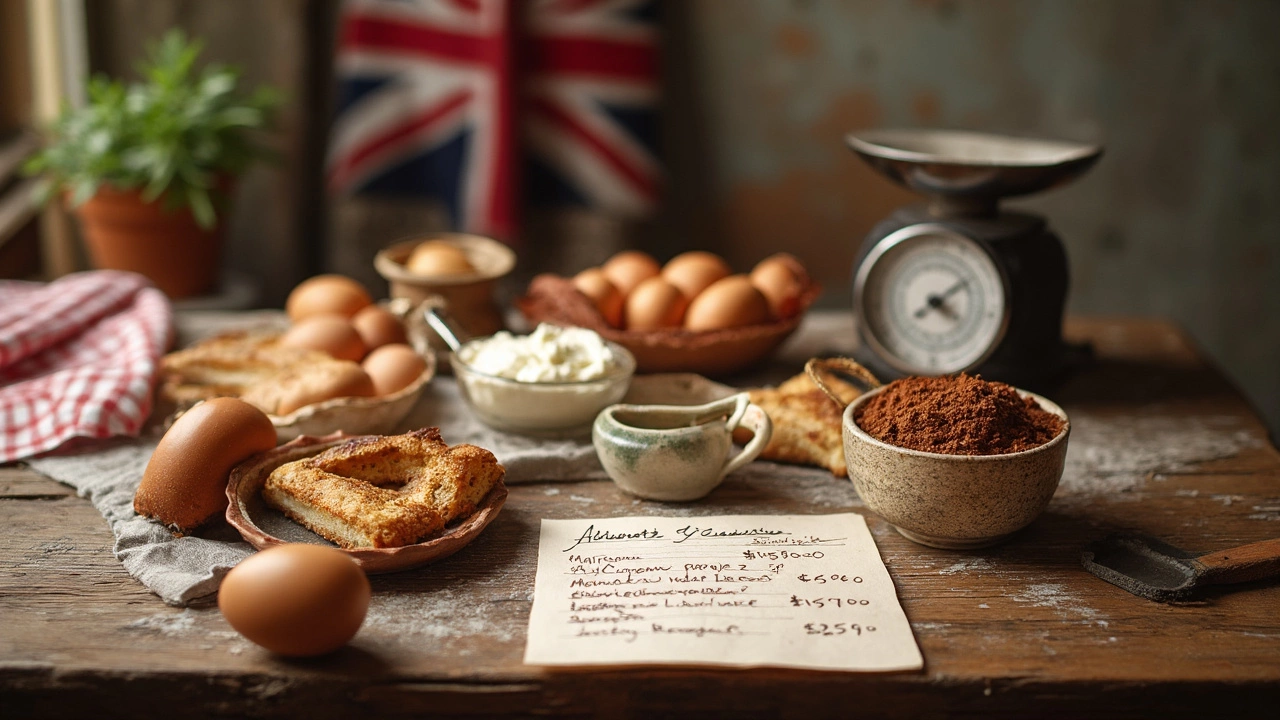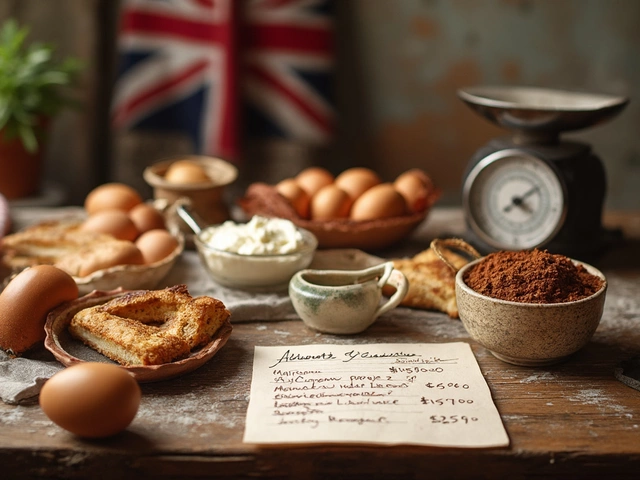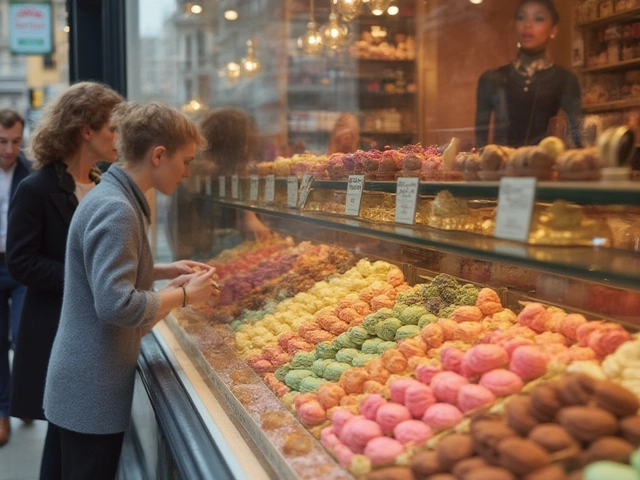
If you’ve got tiramisu on your mind, you might be wondering how much damage it’ll do to your wallet. This classic Italian dessert looks simple, but the price tag can surprise you—especially if you’re eyeing restaurant menus or thinking about making your own at home.
Let’s get practical: the biggest slice of the cost comes from the ingredients. Mascarpone cheese, real espresso, ladyfingers, good cocoa powder, and a splash of honest-to-goodness liqueur aren’t exactly the cheapest items in the grocery store. If you’re thinking of making tiramisu for a party, start by checking what you already have in your kitchen, because buying everything from scratch can add up fast.
Restaurant tiramisu? That’s a different ballgame. Prices for one slice at a mid-range place in big cities usually sit between $6 and $12. Order it at a fancy spot or during a special event, and the bill climbs even higher. But is it really better than homemade? Unpacking that is where the fun (and the savings!) begin.
- The True Cost of Homemade Tiramisu
- Restaurant vs. Homemade: Where's the Better Deal?
- What Makes Tiramisu Expensive?
- Cheap Tricks: Saving Money on Tiramisu
- Tiramisu for Special Occasions: Is it Worth the Splurge?
The True Cost of Homemade Tiramisu
Everyone thinks making tiramisu at home saves a ton, but the numbers can be surprising. Let’s break down the price for a classic batch that serves six people. Based on June 2025 grocery prices in the US, here’s what you’re looking at if you buy everything new:
| Ingredient | Brand Example | Quantity Needed | Average Price |
|---|---|---|---|
| Mascarpone cheese | BelGioioso | 8 oz (1 tub) | $5.99 |
| Ladyfingers | Savoiardi | 24 pieces (about 7 oz) | $4.29 |
| Espresso or strong coffee | Lavazza | 1 cup | $0.80 |
| Eggs | Any | 3 large | $0.90 |
| Sugar | Domino | 1/2 cup | $0.30 |
| Cocoa powder | Ghirardelli | 2 tbsp | $0.60 |
| Marsala wine/liqueur | Florio | 1/4 cup | $2.00 |
Add it up, and you get about $14.88 per tray. That’s $2.48 per generous serving. If you skip the alcohol or already have espresso, you’ll spend even less.
You really feel the savings when you need more than two servings—store-bought tiramisu in ready-to-eat trays runs $25 to $35 for a similar size. Making it yourself costs less than half and tastes better if you get those layers right.
Got some of these ingredients already? Even better. Tiramisu is a great dessert to make the most out of staple kitchen stock. The priciest thing by far is usually the mascarpone cheese. If you’re really pinching pennies, you can even DIY a version with whipped cream cheese or blend mascarpone with a little heavy cream and sugar.
Remember, homemade does take work. There’s beating eggs, dipping ladyfingers fast (so they don’t fall apart), and the patience to let it chill in the fridge for hours—at least four, but overnight is best. If you want to impress for less, though, it honestly can’t be beat.
Restaurant vs. Homemade: Where's the Better Deal?
So, should you shell out for tiramisu at your favorite spot or whip up your own? The answer depends on what you want—convenience, taste, price, or bragging rights.
First up, let’s break down the math. Making tiramisu at home usually costs less per serving, especially if you’re feeding a crowd. That’s because one pan serves 8-10 and the main cost is up front for the ingredients. In contrast, a single portion at a restaurant racks up fast because you’re not just paying for dessert—you’re also covering staff wages, rent, and that fancy plating.
| Homemade (8 servings) | Restaurant (per slice) | |
|---|---|---|
| Mascarpone | $7 (whole tub) | Included |
| Ladyfingers | $4 (1 box) | Included |
| Espresso/Coffee | $1 | Included |
| Eggs, Sugar, Cocoa, etc. | $5 | Included |
| Liqueur (optional) | $6 (small bottle) | Included |
| Tiramisu cost | $23 (total) | $9 (average, per slice) |
| Cost per serving | around $2.90 | $9 |
Here’s the truth: for every $9 slice at the restaurant, you could have made a generous helping for a whole group at home, at under $3 a serving. Not everyone wants to mess with raw eggs or search the store for mascarpone, but the savings are real.
- Restaurants offer consistency and no cleanup, but you pay for the ease.
- Homemade means more dessert for less money—plus, you can tweak flavors or booze as you like.
If you’re tight on time or just want to treat yourself after a meal out, go for the restaurant. But if you love kitchen projects or want to stretch your dollars, homemade tiramisu is the clear winner for tiramisu cost.

What Makes Tiramisu Expensive?
Tiramisu might look simple, but a lot goes into that creamy slice. The price is mostly about the ingredients and the care needed to put it together. Let's break down what bumps up the cost.
Tiramisu cost starts with mascarpone cheese. This isn’t your everyday cream cheese—it’s richer, imported, and usually costs more than double what you’d pay for other soft cheeses. Even in 2025, a small 8oz (225g) tub of mascarpone can set you back around $7 to $9 in most major US cities.
Here’s how the main ingredients typically price out:
| Ingredient | Average Cost (US, June 2025) |
|---|---|
| Mascarpone (8oz/225g) | $7.50 |
| Ladyfingers (24 count) | $4.00 |
| Espresso coffee (for 2 cups) | $1.50 |
| Eggs (6) | $2.00 |
| Cocoa powder (premium, 3 tbsp) | $1.00 |
| Liqueur (Marsala or coffee liqueur, 1/4 cup) | $3.00 |
All combined, a basic homemade tiramisu easily crosses $19 in materials, and that’s if you already have sugar and vanilla at home. Swap in organic eggs, high-end cocoa, or a fancier liqueur, and the tab grows.
Labor is another hidden cost—whipping up tiramisu isn’t quick. Making proper zabaglione (that eggy custard) takes around 30 minutes with all the mixing and layering. In a busy restaurant, that labor adds up fast, and that cost lands right on your plate.
Lastly, tiramisu’s short shelf life matters. Because it’s made with raw eggs and fresh mascarpone, restaurants can’t keep it around for long. If they don’t sell a batch in a day or two, it’s wasted. So, you’re also covering waste and risk in every slice you buy out.
- Imported ingredients drive prices higher.
- Labor and careful handling mean extra expense in restaurants.
- The short shelf life means potential waste, especially for businesses.
So the next time you fork up $8 for tiramisu at a café, you’re really paying for quality ingredients, the time it takes to make it right, and avoiding food waste on their end.
Cheap Tricks: Saving Money on Tiramisu
Tiramisu doesn’t have to wreck your monthly budget. There are so many ways to cut costs and still end up with a dessert that brings that coffee-and-cream wow factor. Here’s what you can actually do to keep it cheap — without making anyone regret dessert!
- Swap mascarpone for cream cheese or ricotta. Let’s be real: mascarpone is delicious, but it’s pricey. Cream cheese from the fridge section or blended ricotta will do the trick for less. If you want a balance, try mixing half mascarpone and half cream cheese.
- Use regular or homemade ladyfingers. Instead of imported Savoiardi, go for store-brand ladyfingers (sometimes called sponge fingers) or bake a quick sponge cake and cut it into strips. You save a few bucks, and nobody will mind as long as they’re soaked in espresso.
- Brew strong coffee instead of buying espresso. Fancy espresso shots cost more; good old filter coffee or stovetop moka pot will get you there, just make it strong.
- Skip the alcohol. Classic tiramisu uses Marsala wine, rum, or coffee liqueur, but you can totally leave it out or add a dash of vanilla. Zero judgment and more money in your pocket.
- Buy ingredients in bulk. If you’re making tiramisu often or for a big group, grab the bigger tubs and multi-packs—per serving, it’s so much cheaper.
To show you the price difference, check out this side-by-side:
| Ingredient | Standard (Brand-Name) | Budget Alternative |
|---|---|---|
| Mascarpone (250g) | $6.00 | Cream cheese ($2.50) |
| Ladyfingers (400g) | $5.00 (Imported) | $2.00 (Store-brand) |
| Espresso (8 shots) | $4.00 (Cafe) | $0.50 (Homemade coffee) |
| Cocoa powder (50g) | $2.00 | $2.00 |
| Liqueur (100ml) | $5.00 | $0.00 (Skip it) |
You save around $12 just by swapping a few things out. That’s enough for another homemade batch or to splurge on better cocoa. The bottom line? Tiramisu cost is up to you, and smart swaps make it a real treat for your taste buds and wallet.

Tiramisu for Special Occasions: Is it Worth the Splurge?
Planning to serve tiramisu at a birthday, wedding, or holiday dinner? It sounds fancy, but it can also get pricey—sometimes a whole tiramisu cake will run you between $25 and $65 at a decent bakery. Special orders from popular Italian dessert shops in cities like New York or São Paulo often sit in the $40+ range, and if you need gluten-free, vegan, or alcohol-free, tack on a little extra.
The main costs for occasion tiramisu balloon because of fresh, high-quality ingredients and the labor. Bakeries will often make tiramisu to order, which means pulling espresso, whipping mascarpone, and assembling everything for maximum freshness. If it’s for a wedding or banquet, you might even see special decoration fees or a per-plate serving charge. It adds up.
Want to add a personal touch and save money? Making it yourself for a group—say, 10-15 people—will usually cost less than $30 (unless you go wild with organic mascarpone and real espresso beans). You can prep it a day ahead, so you’re not stuck in the kitchen during your own party. Just be sure you have space in the fridge for a giant pan.
Here’s when it makes sense to splurge on bakery tiramisu:
- You want a perfect look and zero hassle for an important event.
- You’re short on time or can’t spare fridge space.
- You want specialty versions, like gluten-free or fancy custom flavors.
But if you’re cool with rolling up your sleeves and want to stretch your budget, homemade is the way to go. Tiramisu also keeps well overnight in the fridge, so it’s easy to make ahead and serve later.
“The joy of tiramisu isn’t just about how it tastes or looks, but how it brings people together at a table,” says Grazia Soncini, chef-owner of La Capanna di Eraclio, whose family has been making tiramisu for generations in Italy.
Bottom line: Splurging on tiramisu can be worth it for a truly special occasion or when you need a surefire showstopper. But for family gatherings or friendly potlucks, a DIY tiramisu will deliver on flavor and memories without blowing the budget. When you break down what goes into the price of tiramisu cost, it’s mostly about convenience, quality, and a little peace of mind.









Write a comment